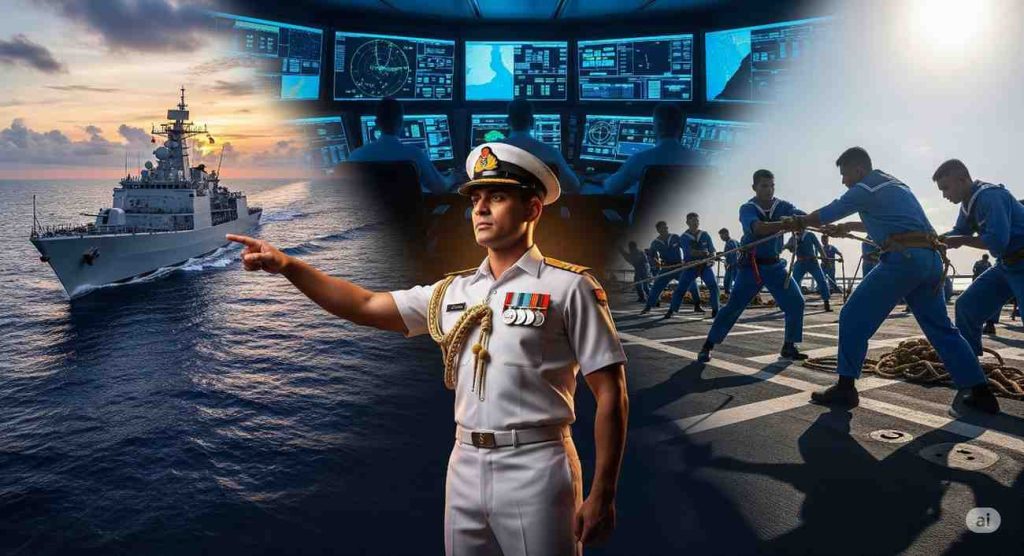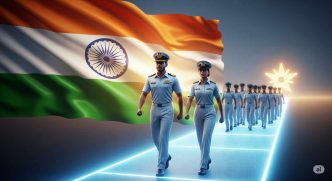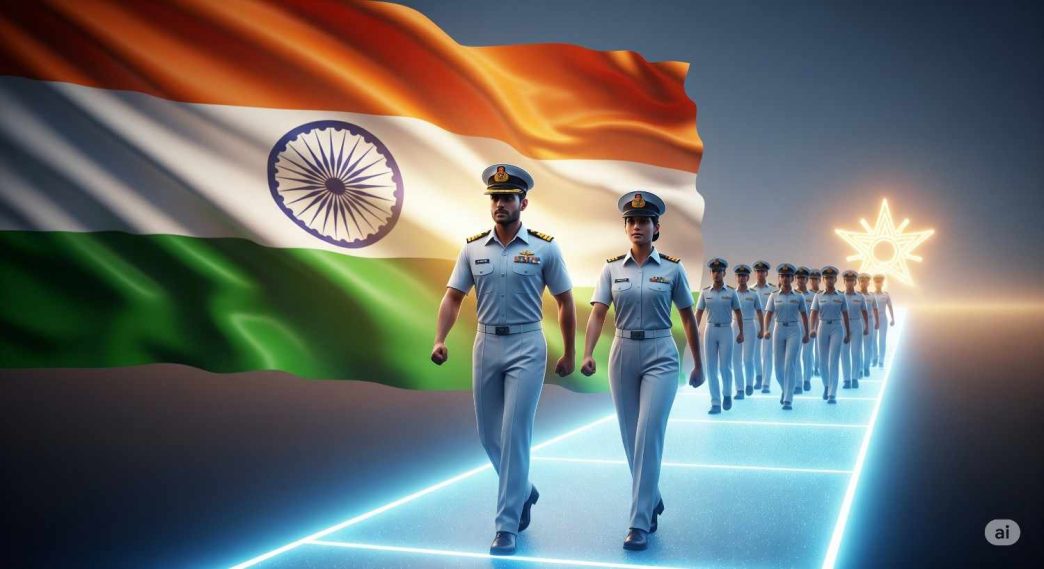Ready to serve your country? Unlock the path to becoming an Indian Navy Officer with our detailed guide on eligibility, exams, training, and career progression. Your journey starts here!
Introduction:
Becoming an officer in the Indian Navy is a dream for many young individuals who aspire to serve their nation with honor and distinction. As one of the most respected forces in the world, the Indian Navy offers an exciting and challenging career that combines adventure, leadership, and the opportunity to protect India’s maritime boundaries.
However, the journey to becoming an Indian Navy officer requires more than just a desire to serve. It demands determination, rigorous preparation, and a deep commitment to excellence. Whether you aspire to join as an Executive, Technical, or Logistics Officer, each path offers unique challenges and rewards. This guide is designed to help you navigate the process of becoming an officer, from eligibility criteria and selection exams to the training and career growth opportunities that lie ahead.
In this article, we’ll provide you with everything you need to know about the process, the skills required, and the steps you need to take to achieve success in this prestigious career. If you’re ready to take on a life of responsibility and adventure, this is your ultimate guide to becoming an Indian Navy officer.
1. What Does an Indian Navy Officer Do?

An Indian Navy officer plays a critical role in the protection of India’s maritime interests. They are involved in:
- Strategic Defense: Ensuring maritime security through strategic planning and operations.
- Combat Operations: Engaging in naval warfare, protecting the country’s borders.
- Navigation and Ship Management: Overseeing ship operations, including navigation, technical maintenance, and management.
- Humanitarian Aid and Disaster Relief: Assisting in natural disaster response, search and rescue missions, and peacekeeping operations.
Navy officers are trained to handle complex situations and make crucial decisions quickly, ensuring India’s supremacy at sea.
2. Types of Indian Navy Officers
The Indian Navy offers several types of officer roles based on specialization:
- Executive Branch Officers: Responsible for the overall functioning of the Navy, including navigation, operations, and logistics.
- Technical Branch Officers: Responsible for maintaining and managing technical aspects, such as machinery, weapons, and electronics on Navy ships and submarines.
- Education Branch Officers: These officers are responsible for imparting training to Navy personnel.
- Logistics Branch Officers: They manage resources, supply chains, and essential goods.
- Naval Architects: Specialize in designing and constructing Navy ships and submarines.
3. Eligibility Criteria to Become an Indian Navy Officer
To join the Indian Navy as an officer, candidates must meet the following eligibility requirements:
For Men and Women (both)
- Nationality: Indian citizen.
- Age Limit: Generally, candidates must be between 19 and 24 years of age. However, it can vary depending on the specific branch and exam.
- Educational Qualifications:
- Executive Branch: A bachelor’s degree (B.Tech, BE) from a recognized university.
- Technical Branch: A B.Tech/BE degree in a technical discipline (Mechanical, Electrical, Computer Science, etc.).
- Logistics and Education Branch: A degree in Engineering, MBA, or Postgraduate degree in related fields.
- Medical Fitness: Candidates need to pass the medical standards set by the Indian Navy. Specific criteria regarding eyesight, physical fitness, and health are necessary to qualify.
4. How to Become an Indian Navy Officer: Step-by-Step

Step 1: Choose Your Path
You need to choose which branch of the Navy you want to join: Executive, Technical, Logistics, or Education. Each has different requirements and roles.
Step 2: Clear the Required Exams
There are multiple pathways to join the Indian Navy:
- National Defence Academy (NDA) Exam: The NDA exam is conducted by the Union Public Service Commission (UPSC). The exam is open to candidates who have completed 10+2 and wish to join the Navy after completing their training at NDA, Pune.
- Combined Defence Services (CDS) Exam: For graduates, the CDS exam is conducted by UPSC. Successful candidates undergo training at the Indian Naval Academy (INA), Ezhimala.
- Indian Navy Entrance Test (INET): The INET exam is specifically for candidates seeking to join the Indian Navy. This test is for various branches such as the Executive, Technical, and Education branches.
- University Entry Scheme (UES): If you are in the final year of your engineering course, the UES exam gives you a chance to join the Indian Navy directly as an officer.
- Direct Entry Scheme: This scheme is for those who have specific educational qualifications (e.g., engineers, medical professionals) and are directly recruited as officers.
Step 3: SSB Interview and Medical Examination
Once you clear the written exam, the next step is the Service Selection Board (SSB) Interview. This is a rigorous process that evaluates your personality, intelligence, physical fitness, and overall suitability for the officer role.
The medical examination follows, where you must meet the physical and medical standards laid out by the Navy.
Step 4: Training
After successfully passing the SSB interview and medical exams, you will undergo training at one of the prestigious academies:
- National Defence Academy (NDA) for those who have cleared the NDA exam.
- Indian Naval Academy (INA) for those clearing the CDS, INET, or other exams.
Training is intense and includes physical training, military tactics, naval operations, and leadership development.
5. Key Skills Required to Succeed as an Indian Navy Officer
To thrive as an Indian Navy officer, certain skills are essential:
- Leadership Skills: As an officer, you’ll be expected to lead a team, make tough decisions, and manage high-pressure situations.
- Physical Fitness: Maintaining peak physical condition is a must in the Navy.
- Mental Resilience: Officers face challenging situations, both on land and at sea. Staying calm and composed under pressure is crucial.
- Technical Knowledge: Depending on the branch, officers need to be well-versed in the latest technology, naval equipment, and machinery.
6. Career Growth and Opportunities
Once you join the Indian Navy, a clear career progression path awaits you. After initial training, you begin your service as a Sub-Lieutenant, progressing to the rank of Lieutenant, Lieutenant Commander, and then Commander. The growth continues further, with opportunities to rise to Captain, Commodore, and Vice-Admiral.
7. Salary and Benefits
The salary of an Indian Navy officer depends on the rank and experience. Officers receive allowances, insurance, and pension benefits. In addition to a competitive salary, Navy officers enjoy various perks like:
- Free healthcare and medical facilities.
- Government accommodation.
- Opportunities for travel and exposure to different cultures.
- Retirement benefits and pension schemes.
8. Challenges of Being an Indian Navy Officer

While serving in the Indian Navy comes with immense pride and responsibility, it also comes with certain challenges:
- Deployment at Sea: Officers can be away from family for long periods during deployments.
- High-Pressure Environment: The Navy is a high-stakes environment that requires you to make quick decisions that can impact lives.
- Physical Demands: The training and daily tasks require physical endurance and mental resilience.
9. Frequently Asked Questions (FAQ)
Q1: What are the eligibility criteria for joining the Indian Navy as an officer?
Eligibility depends on the branch you wish to join. Generally, you need to be a graduate in a relevant discipline, with an age limit between 19-24 years. Specific medical and fitness standards must also be met.
Q2: How do I apply for Indian Navy Officer positions?
You can apply through exams like the NDA, CDS, INET, or the University Entry Scheme (UES). Keep an eye on official notifications for application dates and procedures.
Q3: What is the salary of an Indian Navy Officer?
The salary varies with rank but typically ranges from ₹56,100 to ₹1,77,500 per month for a Sub-Lieutenant to higher ranks. Officers also receive allowances and additional benefits.
Q4: How long is the training to become an Indian Navy Officer?
Training duration can vary based on the academy and course. The NDA training lasts 3 years, while the INA training lasts approximately 1.5 years after clearing the exams.
Q5: Can women join the Indian Navy as officers?
Yes, women are eligible to join the Indian Navy as officers in certain branches like the Executive, Education, and Logistics.
Q6: What is the Service Selection Board (SSB) interview?
The SSB is a 5-day selection process that evaluates your physical, psychological, and leadership potential. It includes group tasks, personal interviews, and written tests.
Conclusion
Becoming an Indian Navy officer is a rewarding and prestigious career choice. It requires a combination of academic excellence, physical fitness, mental toughness, and leadership ability. With the right preparation, dedication, and determination, you can join the ranks of the brave men and women who serve to protect the nation’s maritime borders. This guide has laid out the roadmap, but your journey begins with the first step towards success.
Know more related:
Rule of Law in India Made Simple for Beginners








